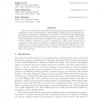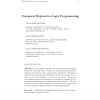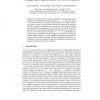1020 search results - page 13 / 204 » Tight Semantics for Logic Programs |
WILF
2005
Springer
14 years 1 months ago
2005
Springer
A prospective study of the use of ordered multi-lattices as underlying sets of truth-values for a generalised framework of logic programming is presented. Specifically, we investi...
JAIR
2007
13 years 7 months ago
2007
This work is a contribution to prioritized reasoning in logic programming in the presence of preference relations involving atoms. The technique, providing a new interpretation fo...
NGC
2000
Springer
13 years 7 months ago
2000
Springer
In this paper we introduce the logic programminglanguage Disjunctive Chronolog which combines the programming paradigms of temporal and disjunctive logic programming. Disjunctive C...
ICLP
2009
Springer
14 years 8 months ago
2009
Springer
This paper considers a semantic approach for merging logic programs under answer set semantics. Given logic programs P1, . . . , Pn, the goal is to provide characterisations of the...
LANMR
2007
13 years 9 months ago
2007
Abstract We study the notion of strong equivalence between two disjunctive logic programs under the G3-stable model semantics, also called the P-stable semantics, and we show how s...



